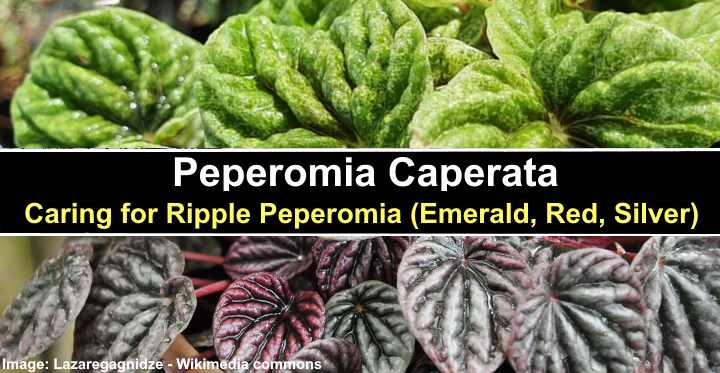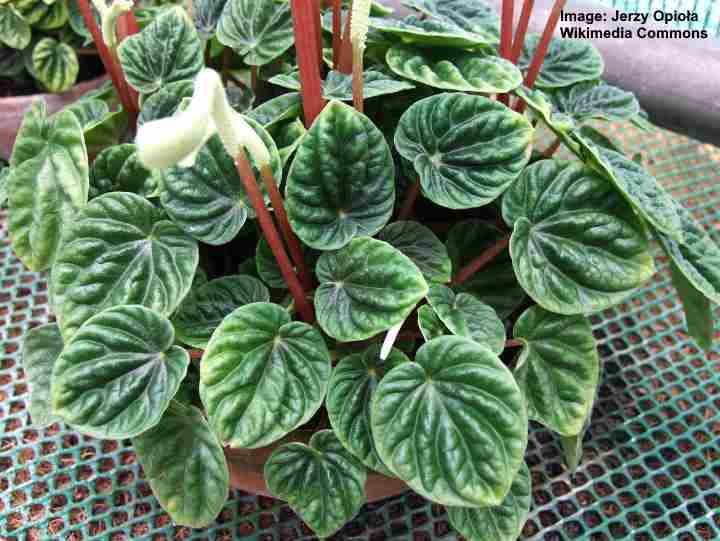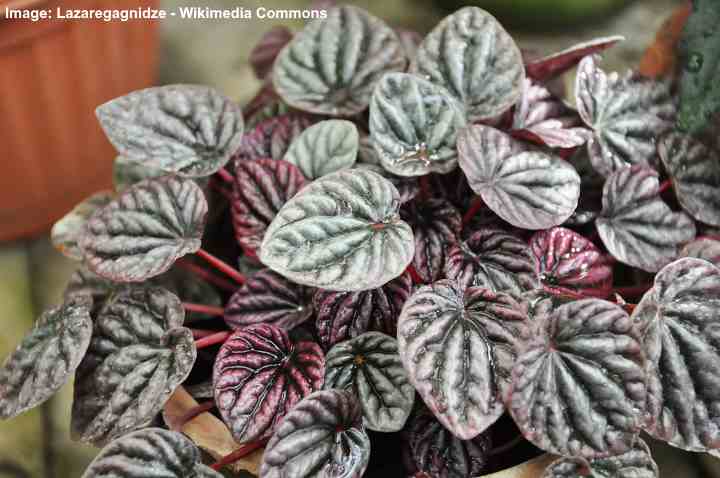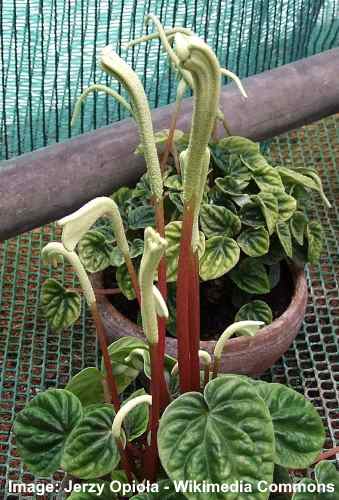Peperomia Caperata: How to Care For Ripple Peperomia (Emerald, Red, Silver)

The Peperomia caperata (Ripple Peperomia) is a flowering evergreen houseplant with wrinkled, heart-shaped leaves with a metallic sheen. The ripple peperomias crinkly leaves can be hues of silver, red, or rich green. A common variety of Peperomia caperata is the Emerald Ripple Peperomia with its shiny, dark green deeply puckered leaves and compact growth.
This article is a complete care guide to growing the emerald ripple peperomia (Peperomia caperata). In addition to helpful tips on caring for this delightful indoor plant, you’ll find out about other spectacular varieties of ripple peperomia plants.
How to Care for Peperomia Caperata
To care for a ripple peperomia, grow the Peperomia caperata in bright, indirect sunlight, a porous well-draining potting soil, and average room temperatures and humidity. It’s best to water the plant when the soil partially dries. Fertilize ripple peperomia houseplants monthly during the growing season with diluted houseplant fertilizer.
About Peperomia Caperata (Ripple Peperomia)
The ripple peperomia is a tropical flowering perennial native to the rainforests of Brazil. It’s an evergreen plant that grows in clumps in dappled sunlight on the forest floor. The warm, humid conditions of tropical climates ensure the growth of healthy, lush foliage.
Peperomia caperata (Ripple peperomia) is a species of plant in the genus Peperomia and family Piperaceae. There are over 1,000 species of peperomia, many of which make for stunning foliage houseplants.
Ripple peperomia is a slow-growing houseplant and doesn’t grow taller than 8” (20 cm). Its attractive feature is the waxy, thick heart-shaped leaves that have a crinkled or puckered appearance. Spiked flowers (inflorescence) also add to the plant’s appealing characteristics.
Like most peperomia species, the Peperomia caperata is a semi-succulent plant. Its epiphytic roots mean that emerald ripple peperomias need to grow in a light, aerated potting medium where oxygen and moisture can get to the plant’s roots.
Houseplants in the Peperomia genus are also referred to as radiator plants. The common name comes from the fact that peperomia plants thrive in warm air and sunlight. However, these versatile indoor plants also grow well in the shade and drier climates.
Apart from ripple peperomia, other names for Peperomia caperata include green ripple peperomia, ivy-leaf peperomia, metallic peperomia, and silver heart.
Because the emerald ripple peperomia doesn’t survive temperatures below 50°F (10°C), it is grown as a houseplant in temperate climates.
Types of Peperomia Caperata (Ripple Peperomia)
Ripple peperomia is just one species of thousands of peperomia plants. However, within the species Peperomia caperata, there are many beautiful cultivars. Here are a few types of ripple peperomia that are worthy of consideration.
Peperomia caperata ‘Emerald’ (Emerald Ripple Peperomia)

Peperomia caperata ‘Emerald’
The emerald ripple peperomia has a bushy compact growth. Its heart-shaped, dark-green rippled leaves have deeply puckered veins. Emerald ripple peperomias also have white flowering spikes that appear on the ends of red stems.
Peperomia caperata ‘Ripple Red’ (Red Ripple Peperomia)

Peperomia caperata ‘Ripple Red’
The ripple red peperomia has heart-shaped crinkled leaves that have iridescent burgundy red coloring. The metallic corrugated peperomia leaves give this epiphytic houseplant an exotic look. This mound-forming peperomia grows up to 8” (20 cm) tall and the same width.
Peperomia caperata ‘Silver Ripple’ (Silver Peperomia)
The silver ripple peperomia has silvery corrugated cordate (heart-shaped) leaves. Its wrinkled leaves have tinges of green and silver, with some varieties having a silver shimmer.
Peperomia caperata ‘Rosso’

Peperomia caperata ‘Rosso’
The peperomia ‘Rosso’ is an unusual species of Peperomia caperata because it has lance-shaped, slightly grooved leaves. The lanceolate pointed leaves have deep green upper sides and maroon undersides, as well as red stems. Peperomia ‘Rosso’ is a flowering epiphytic indoor plant that produces yellowish-green inflorescences on the end of short red stems.
Other beautiful examples of variegated ripple peperomia cultivars include the pink and green Peperomia caperata ‘Pink Lady’ and the dark green and red Peperomia caperata ‘Teresa.’
Ripple Peperomia Leaves
The characteristic feature of Peperomia caperata is its heart-shaped, wrinkled leaves. The puckered dark veins contrasting with the raised ridges and metallic sheen give the foliage a ‘space-age,’ exotic look. The dense, compact evergreen leaf growth means that the ripple peperomia is an ideal indoor plant for homes or offices.
Ripple peperomia leaves are described as cordate, with a corrugated surface and impressed veins. The leaves measure between 1” and 3” (2.5 – 7.5 cm) and grow on the ends of red 3-inch (7.5-cm) petioles (stems).
Ripple Peperomia Flower

Peperomia caperata flowers
Ripple peperomia flowers are white flower spikes called inflorescences growing on the end of red stems. The flowers tend to be a creamy-white color. Depending on the growing conditions, ripple peperomia plants bloom in summer or fall. Ripple peperomia flowers look like the stamens on arum lilies but without the modified colorful leaf.
How to Care for Ripple Peperomia (Peperomia caperata)
Let’s look in more detail at the best way to care for Peperomia caperata at home to ensure the beautiful waxy leaves keep their shiny, rippled appearance.
Peperomia caperata Light Requirements
Emerald ripple peperomia thrives in medium to bright light, protected from direct sunlight. The plant grows well on an east-facing windowsill in a bright room. Near a south- or west-facing window, it’s best to filter sunlight through a sheer curtain. Intense direct sun can scorch the waxy peperomia leaves and make them dull.
Ripple peperomia plants tolerate growing in low-light environments. These plants grow well in dark rooms such as bedrooms or north-facing rooms. Radiator plants such as the ripple peperomia may begin to lose their leaf color if they grow in the dark for too long. If this happens, move the plant to a brighter room.
Any species of Peperomia caperata is ideal as a tabletop office plant. The emerald peperomia, ripple red peperomia, and silver ripple peperomia all perform well under fluorescent lights.
The Best Soil for Growing Peperomia caperata
The ripple peperomia grows best in rich aerated, loose potting soil that has excellent drainage. An ideal peperomia soil mix combines two parts peat moss, one part horticultural sand, and one part perlite. The best growing medium should retain some moisture but let water drain freely.
Peperomia caperata is an epiphytic plant that needs air and moisture to provide nutrients. You can also use commercial potting soil for peperomias and then amend it with gravel, perlite, or orchid bark to improve drainage. Ideally, the peperomia soil should dry out relatively fast between watering.
It’s good to remember that emerald ripple peperomia plants are intolerant of wet, soggy soil. So, always ensure that the potting mix is never waterlogged. On the other hand, dry soil will also affect the peperomia’s growth.
Related reading: How to make a DIY potting mix.
How to Water Ripple Peperomia (Peperomia caperata)
Properly watering a ripple peperomia is the most critical care factor for growing this hardy houseplant. Only water the potted peperomia when the top 2” to 3” (5 – 7.5 cm) is dry. Then thoroughly douse the soil with room-temperature filtered water until it drains from the pot’s drainage holes.
You may need to water an emerald ripple peperomia as often as once a week in spring and summer. In winter, you may only need to water the bushy houseplant every two or three weeks. But, before you water a peperomia, make sure the top layer of soil is dry.
Emerald ripple peperomia is easy to care for at home. The plant is tolerant of drought and can survive with occasional watering.
The best way to water houseplants—including ripple peperomia—is to soak the soil and then let it dry between watering. This plant watering method ensures healthy growth because the roots are constantly moist without becoming soggy.
Temperature Range for Peperomia caperata Houseplants
The ripple peperomia grows well in average room temperatures. Its ideal temperature range is between 65°F and 80°F (18°C – 26°C). Because peperomias are native to tropical climates, never let the temperature fall below 50°F (10°C). Generally, if you feel comfortable, the ripple peperomia is growing at the right temperature.
Although average home temperatures are ideal for healthy ripple peperomia growth, there are a few things to be careful of. For example, drafts from open windows or air conditioning units can wilt the plant’s growth.
Even though the ripple peperomia is a radiator plant, growing beside a hot air vent or furnace can stress the plant and cause its foliage to wilt.
Humidity Requirements to Grow Peperomia caperata Indoors
The ripple peperomia grows well in medium to low humidity. In typical household conditions, you don’t need to worry about humidity levels. Although this tropical rainforest plant grows in humid conditions, potted houseplants adapt well to home humidity levels.
You can mist Peperomia caperata leaves to keep them moist. You can also wipe them with a damp cloth once a week to moisten them and clean dust from the leaves. If your home has particularly dry air, then you can place the ripple peperomia on a pebble tray filled with water.
How to Fertilize Peperomia caperata for Healthy Growth
The ripple peperomia isn’t a heavy feeder. So, you only need to apply a diluted houseplant fertilizer once a month during the growing season. This additional feeding during spring and summer can keep the corrugated, ridged leaves looking their best.
You may find that varieties of ripple peperomia grow well without additional feeding. In most cases, the best way to care for a ripple peperomia is to place it in bright, filtered light and only water it when the soil dries.
Peperomia caperata Growth Rate
All varieties of peperomia, including the emerald ripple peperomia, are slow growers. Under ideal conditions, a ripple peperomia grows to about 8” (20 cm) tall with a spread up to 8” (20 cm). The Peperomia caperata grows fastest in filtered light and partially moist soil.
Pruning Ripple Peperomia
Peperomia caperata rarely requires any pruning. This mound-forming peperomia has a natural bushy, rounded growth without having to prune the foliage. You can snip off stems from the ripple peperomia if they’ve become leggy or show signs of decay.
How to Propagate Peperomia caperata
Ripple peperomia propagation is best done by stem cuttings or leaf cuttings. Like many succulents, peperomia plants root easily in a well-draining potting mix. Even leaves that fall on the soil easily take root.
To propagate a ripple peperomia, cut a few healthy leaves along with the stems. Leave on a paper towel to dry for a day or two. Then, place the stem in a loose, moist potting mix so that the leaf is touching the soil. Cover with plastic, put in a bright place, and keep the soil slightly moist.
After four to eight weeks, you should notice new plants growing from the propagated peperomia leaf’s base.
How to Repot Ripple Peperomia
Repotting Peperomia caperata can help give the roots more room to grow and encourage growth. However, ripple peperomia plants don’t require frequent repotting—usually, every two or three years is enough. Repotting a peperomia is also a good idea to refresh the potting soil.
Before repotting the ripple peperomia, choose a pot one size larger than the current one. Gently remove the plant from its existing container. Shake excess dirt free from the roots and remove any dead, mushy ones. Half-fill the new pot with an appropriate potting mix and place the peperomia in its new pot, ensuring it grows at the same height as before.
Thoroughly water the soil and place it in a bright, draft-free location for best growth.
Pests Affecting Peperomia caperata Growth
The ripple peperomia is relatively resistant to common houseplant pests and bugs. A healthy Peperomia caperata rarely has issues with mealybugs, aphids, or spider mites. Keeping peperomia plants in bright, filtered sunlight and only watering when necessary helps keep pests away.
If you notice any signs of aphids, mealybugs, or spider mites, treat the plant’s leaves with a neem oil solution. Mix 2 tsp. neem oil and 1 tsp. dish soap with 1 quart (1 l) of warm water in a spray canister. Apply the neem oil remedy to the foliage so that it covers both sides of the leaves. Use the natural pesticide weekly to get rid of houseplant pests.
Diseases affecting Peperomia caperata Growth
Proper ripple peperomia care means that you’ll avoid diseases that affect the plant’s growth. Typically, potting soil moisture issues with a Peperomia caperata result in weakened growth, mushy black stems, and plant death.
Here are a few helpful care tips to prevent ripple peperomia disease:
- Never overwater the ripple peperomia.
- Avoid the plant from becoming root-bound as water doesn’t drain well.
- Keep the peperomia plant in a warm, bright location to prevent dampness and mold.
- Always grow Peperomia caperata in a loose, porous, aerated potting mix.
Is Peperomia caperata Toxic
The emerald ripple peperomia plant is not toxic to cats or dogs. The ASPCA lists Peperomia caperata on its list of non-toxic houseplants.
FAQs About Peperomia Caperata Care
Emerald ripple peperomia plants are generally easy to care for indoors. However, a few signs can indicate that a peperomia houseplant is stressed. Here are some helpful tips on resolving some care issues
Why are my Emerald Ripple Peperomia stems turning black?
Ripple peperomia stems and leaves turning black is usually a sign of overwatering. Soggy, overly-damp soil results in root rot and starves the plant of essential nutrients. Also, fungal infections can affect plant growth.
A solution to this problem is to prune the dead or decaying stems. Then hold off watering until the top layer of soil is completely dry. Remember to only water the peperomia as often as the soil partially dries.
Why is my Peperomia caperata plant drooping?
If the rippled peperomia leaves are drooping, this is a sign that the soil is too dry. Ripple peperomia plants perform best when the growing medium around the roots is always slightly moist. The best way to care for the peperomia is to soak the soil at every watering.
What does it mean if ripple peperomia leaves are dull?
A lack of sunlight usually causes emerald ripple peperomia leaves to lose their shine. Although adaptable to low-light, ripple peperomia plants grow best in bright, indirect sunlight. So, if the once shiny, glossy leaves look lackluster, move the compact houseplant to a sunnier location.
Why are ripple peperomia leaves turning brown?
It’s common for the tips of ripple peperomia leaves to turn brown if the plant is in a cold draft. However, brown tips can also indicate underwatering the plant or sun scorch from standing in direct sunlight. So, check the plant’s surroundings to determine the reason why peperomia leaves are turning brown.
Related articles:
- Watermelon Peperomia (Peperomia Argyreia): Care and Growing Guide
- Peperomia Hope: Plant Care and Growing Guide
- Peperomia Obtusifolia (American Baby Rubber Plant): Care and Growing Guide
